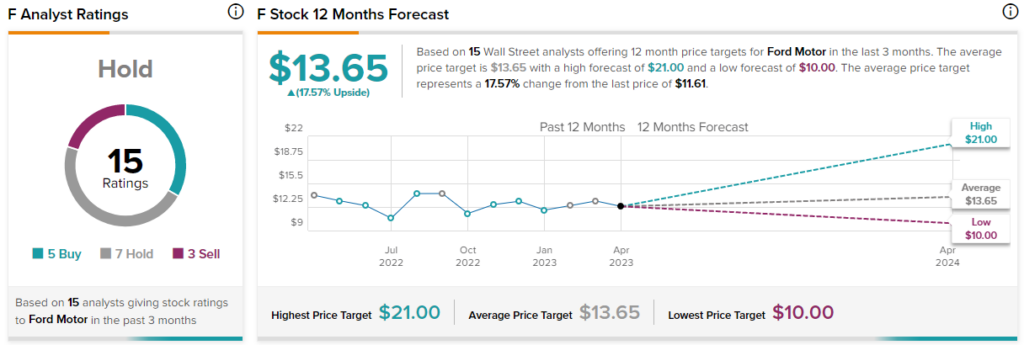Auto giant Ford (NYSE:F) stock is now trading at $11.61, over 50% lower than its all-time high of over $23 seen in January 2022. After losing over 40% in 2022, the stock has gained slightly (5.6% year-to-date). The big question is, is the stock undervalued? Does it make sense to buy now or wait? My belief is that with the ongoing macro uncertainty significantly impacting the auto sector outlook, it’s best to stay on the sidelines despite undervalued stock price levels and attractive long-term growth potential in the electric vehicle (EV) space.
Overall, the auto sector currently has multiple headwinds that make investors wary of auto stocks. Headwinds include high inflation and interest rates curbing vehicle demand, supply-chain issues, potential EV price wars, and overall macro uncertainty further sparked by the recent banking crisis. Still, a stalwart auto company like Ford has stood the test of time. Now, let’s take a look at what’s in store for Ford, going forward.

Ford is Bullish on EV Growth Potential
Ford is leaving no stone unturned to gain a higher market share in the booming EV industry. While pickup trucks, large SUVs, and vans still make a larger share of Ford’s revenues, EVs could be a significant contributor to revenues and profits over the long term.
For instance, to boost EV production, Ford disclosed that it’s investing C$1.8 billion to transform its existing manufacturing hub for the production of next-generation EVs in Canada. This will accelerate the company’s EV production capacity, helping it to be on track to produce two million EVs by the end of 2026.
Further, the company is looking to boost its sales in the booming Chinese market by rebranding its existing EV portfolio to have a better standing against the huge competition in China. The electrification of its existing fleet also offers potential growth opportunities for Ford.
Ford’s EV portfolio is clearly growing, and the company looks set to achieve its target of 600,000 units by the end of 2023. Nevertheless, it’s important to note that Ford’s EV business is expected to report significant losses in the initial years due to the huge research and development costs (approximately 65% of Ford’s total R&D) associated with the segment.
On the positive side, Ford expects to report an 8% margin on its EV business from the long-term target production of 2 million vehicles to be sold annually by 2026. The EV business turning profitable could be a big boost to the company’s existing operating margins.
However, ongoing headwinds in the form of macro uncertainty, supply-chain dynamics, and EV price wars could push Ford’s profitability goals for EVs further away.
More importantly, Ford is enhancing its reporting structure with EVs as a new reported segment. The company will not report revenues by region anymore. Revenues will be reported under three business segments – 1. Blue: its traditional car business; 2. Pro: its commercial and government fleet business, and 3. Model e – its electric-vehicle business. This will give investors a clearer picture of the EV business’ profitability roadmap.
Investors are eagerly waiting for the upcoming Q1 earnings scheduled to release on May 2, especially with the newly-reported business segments. The preceding Q4 results on February 2 failed to meet Wall Street’s expectations. What was even more discouraging was management’s commentary, which revealed that there were internal execution issues within its manufacturing operations that led to subpar results.
Ford Makes Meaningful Investments in EV Battery Production
The auto industry is undergoing a massive evolution after the invention of EVs. EV sales are seeing a significant boom compared to traditional vehicles. However, an EV price war could be incoming based on repetitive price cuts by top EV makers like Tesla (NASDAQ:TSLA) over the past few months. Leading EV makers are now finding ways to minimize their production costs.
Lithium is the buzzword, as it is the primary material used in EVs. So far, EVs depend on global lithium producers for their key input. However, major lithium-rich countries, with an aim to safeguard their natural resources, are nationalizing their lithium deposits or controlling their exports. In such a scenario, building one’s own lithium plant would mean lower costs and leaping the biggest bottleneck of supply constraints for EV giants like Ford.
Likewise, in February, Ford announced that it will collaborate with a China-based battery giant – CATL – to build a new lithium iron phosphate (LFP) battery plant worth $3.5 billion for use in electric vehicles. Based in Michigan, U.S., the plant is expected to start production in 2026. Further, it is collaborating with nickel producers globally to build nickel cobalt manganese (NCM) batteries.
Having its own batteries, instead of depending on a global supplier, will fix a lot of production issues, speed up the production of EVs and likely bring down costs significantly as well. What’s more, the new lithium batteries will be cheaper than the nickel cobalt manganese batteries currently being used in Ford vehicles.
Is Ford Stock a Buy, According to Analysts?
Given the challenges faced by the auto industry at large, Ford Motor stock has received five Buys, seven Holds, and three Sells for a Hold consensus rating. Additionally, Ford stock’s average price forecast of $13.65 implies 17.6% upside potential.

Ford is currently trading at a P/E ratio of 7x, at a significant discount to the peer group median (14x). Further, it’s trading at a lower earnings multiple than its five-year average of 8x.
Conclusion: Remain on the Sidelines
Ford is clearly bullish on the EV industry’s future and is making efforts to capture market share gains in this highly-attractive space. Longer-term, the efforts will likely pay off. However, auto sector headwinds are expected to prevail in the coming months. The EV sector, especially, is struggling with lower demand, increased competition, and pricing wars leading to compressed margins.
With the expectations of waning demand, muted revenue, and margin growth for the next few quarters, I don’t see significant near-term upside for Ford stock. Therefore, I will stay on the sidelines.









